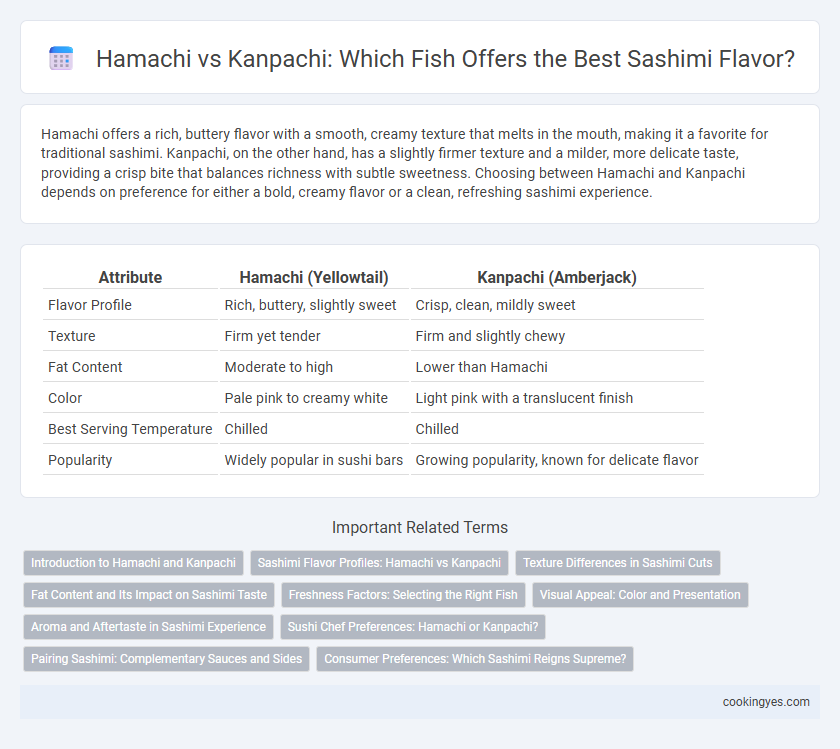Hamachi offers a rich, buttery flavor with a smooth, creamy texture that melts in the mouth, making it a favorite for traditional sashimi. Kanpachi, on the other hand, has a slightly firmer texture and a milder, more delicate taste, providing a crisp bite that balances richness with subtle sweetness. Choosing between Hamachi and Kanpachi depends on preference for either a bold, creamy flavor or a clean, refreshing sashimi experience.
Table of Comparison
| Attribute | Hamachi (Yellowtail) | Kanpachi (Amberjack) |
|---|---|---|
| Flavor Profile | Rich, buttery, slightly sweet | Crisp, clean, mildly sweet |
| Texture | Firm yet tender | Firm and slightly chewy |
| Fat Content | Moderate to high | Lower than Hamachi |
| Color | Pale pink to creamy white | Light pink with a translucent finish |
| Best Serving Temperature | Chilled | Chilled |
| Popularity | Widely popular in sushi bars | Growing popularity, known for delicate flavor |
Introduction to Hamachi and Kanpachi
Hamachi, also known as Japanese amberjack, offers a rich, buttery flavor and a tender texture that makes it a favorite in sashimi dishes. Kanpachi, or greater amberjack, features a milder taste with a firmer, slightly oilier flesh, providing a contrasting experience to hamachi. Both fish are prized for their freshness and delicate umami, making them staples in authentic sashimi selections.
Sashimi Flavor Profiles: Hamachi vs Kanpachi
Hamachi sashimi features a rich, buttery flavor with a smooth, fatty texture, making it prized for its melt-in-the-mouth quality. Kanpachi offers a cleaner, more delicate taste with a firmer, slightly chewy texture and subtle sweetness. The contrast between Hamachi's creamy richness and Kanpachi's crisp freshness defines their distinct sashimi flavor profiles.
Texture Differences in Sashimi Cuts
Hamachi sashimi boasts a rich, buttery texture characterized by higher fat content, resulting in a tender and slightly creamy mouthfeel. Kanpachi offers a firmer, more elastic bite with a leaner flesh that provides a clean and crisp texture, ideal for those who prefer a less fatty sashimi experience. The distinct tactile contrast between Hamachi's softness and Kanpachi's firmness defines their unique appeal in sashimi dishes.
Fat Content and Its Impact on Sashimi Taste
Hamachi sashimi contains a higher fat content compared to Kanpachi, resulting in a richer, creamier texture that enhances its umami flavor. Kanpachi offers a leaner profile with a firmer bite and a cleaner, more delicate taste. The fat content in Hamachi contributes to a buttery mouthfeel, making it preferred for those seeking a luxurious sashimi experience.
Freshness Factors: Selecting the Right Fish
Hamachi sashimi offers a rich, buttery flavor with a delicate texture that emphasizes freshness through its higher fat content and vibrant, pinkish flesh. Kanpachi, known for its firm texture and clean, slightly sweet taste, signals freshness when the flesh is bright white and firm to the touch. Selecting the right fish depends on visual cues like color brightness and firmness, which directly impact the sashimi's flavor and overall freshness experience.
Visual Appeal: Color and Presentation
Hamachi sashimi features a pale pink to light yellow color with a slightly oily texture, creating a rich visual depth that enhances its luxurious presentation. Kanpachi sashimi displays a more translucent white to cream hue with a firmer texture, offering a clean and elegant aesthetic ideal for minimalist plating. Both fishes provide distinct visual appeal that caters to different sashimi presentation styles, emphasizing color contrast and texture variation.
Aroma and Aftertaste in Sashimi Experience
Hamachi sashimi offers a rich, buttery aroma that enhances its creamy texture, delivering a slightly sweet aftertaste that lingers delicately on the palate. Kanpachi provides a cleaner, more subtle fragrance with a crisp, refreshing finish, characterized by a mild umami aftertaste that balances the flavor experience. The contrasting aroma and aftertaste profiles make Hamachi more indulgent, while Kanpachi appeals to those seeking a lighter, fresher sashimi flavor.
Sushi Chef Preferences: Hamachi or Kanpachi?
Sushi chefs often prefer Hamachi for its rich, buttery texture and slightly sweet flavor that enhances sashimi dishes. Kanpachi offers a firmer texture with a cleaner, more delicate taste, appealing to chefs seeking subtlety in flavor profiles. The choice between Hamachi and Kanpachi ultimately depends on the desired balance of richness versus crispness in sashimi preparation.
Pairing Sashimi: Complementary Sauces and Sides
Hamachi sashimi features a buttery, rich flavor that pairs exceptionally well with soy sauce and wasabi, enhancing its smooth texture without overpowering the palate. Kanpachi offers a firmer, slightly nutty taste that complements tangy ponzu sauce and finely grated ginger, balancing its clean, fresh profile. Both types of sashimi benefit from light pickled vegetables or crisp daikon radish, which provide refreshing contrast and elevate the overall umami experience.
Consumer Preferences: Which Sashimi Reigns Supreme?
Hamachi sashimi is favored for its rich, buttery texture and slightly sweet flavor, appealing to consumers who enjoy a creamy mouthfeel. Kanpachi, by contrast, offers a firmer bite and a cleaner, more subtle taste, attracting those who prefer a lighter, more refreshing sashimi option. Consumer preferences often hinge on texture and flavor intensity, with Hamachi leading in popularity for indulgence and Kanpachi preferred for a delicate, crisp experience.
Hamachi vs Kanpachi for sashimi flavor Infographic

 cookingyes.com
cookingyes.com